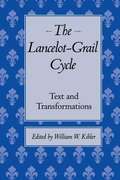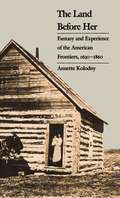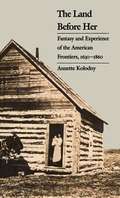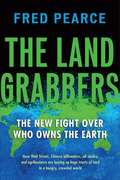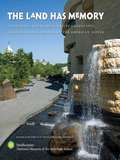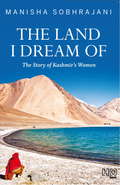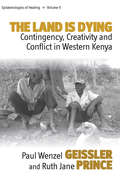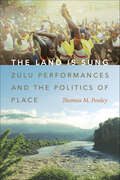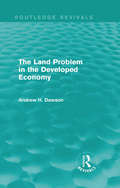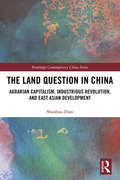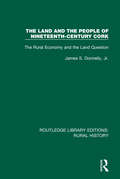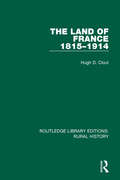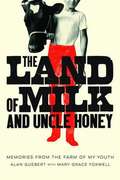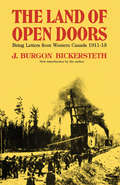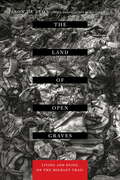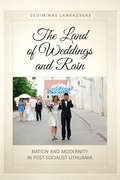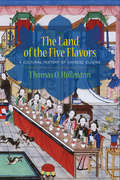- Table View
- List View
The Lancelot-Grail Cycle: Text and Transformations
by William W. KiblerComposed in Old French between about 1220 and 1240, the Lancelot-Grail Cycle is a group of five prose romances centered on the love affair between Lancelot and Guenevere. It consists of an immense central core, the Lancelot Proper, introduced by The History of the Holy Grail and The Story of Merlin and concluded by The Quest for the Holy Grail and The Death of Arthur. <P><P> This volume brings together thirteen essays by noted scholars from the first symposium ever devoted exclusively to the Lancelot-Grail Cycle. Exploring the cycle's evolution across the literatures of medieval France, Italy, Spain, Catalonia, and England, the authors take a variety of approaches that highlight a broad range of cultural, social, historical, and political concerns and offer a comparative and interdisciplinary vision of this great romance.
The Land Before Her
by Annette KolodnyTo discover how women constructed their own mythology of the West, Kolodny examines the evidence of three generations of women's writing about the frontier. She finds that, although the American frontiersman imagined the wilderness as virgin land, an unspoiled Eve to be taken, the pioneer woman at his side dreamed more modestly of a garden to be cultivated. Both intellectual and cultural history, this volume continues Kolodny's study of frontier mythology begun in The Lay of the Land.
The Land Before Her: Fantasy and Experience of the American Frontier 1630-1860
by Annette KolodnyPreface The purpose of this study is to chart women's private responses to the successive American frontiers and to trace a tradition of women's public statements about the west. The attention accorded letters and diaries should not suggest that this is a study of the daily lives of pioneer women, however. Nor should the analysis of three centuries of published materials suggest that I have attempted any definitive literary history. Although I have made extensive use of letters and diaries composed between 1630 and 1860, I have not attempted a revisionist history of the westward movement as seen through the eyes of women. Such a history is nonetheless long overdue, and I sincerely hope my chapters may encourage further work toward that end. In that event, my contribution may be the reminder that white women began as pioneers to this continent in the seventeenth century. Only by acknowledging the fullness of that history will we be able to grasp the continuities linking later generations with what had gone before.
The Land Grabbers
by Fred PearceAn unprecedented land grab is taking place around the world. Fearing future food shortages or eager to profit from them, the world’s wealthiest and most acquisitive countries, corporations, and individuals have been buying and leasing vast tracts of land around the world. The scale is astounding: parcels the size of small countries are being gobbled up across the plains of Africa, the paddy fields of Southeast Asia, the jungles of South America, and the prairies of Eastern Europe. Veteran science writer Fred Pearce spent a year circling the globe to find out who was doing the buying, whose land was being taken over, and what the effect of these massive land deals seems to be. The Land Grabbersis a first-of-its-kind exposé that reveals the scale and the human costs of the land grab, one of the most profound ethical, environmental, and economic issues facing the globalized world in the twenty-first century. The corporations, speculators, and governments scooping up land cheap in the developing world claim that industrial-scale farming will help local economies. But Pearce’s research reveals a far more troubling reality. While some mega-farms are ethically run, all too often poor farmers and cattle herders are evicted from ancestral lands or cut off from water sources. The good jobs promised by foreign capitalists and home governments alike fail to materialize. Hungry nations are being forced to export their food to the wealthy, and corporate potentates run fiefdoms oblivious to the country beyond their fences. Pearce’s story is populated with larger-than-life characters, from financier George Soros and industry tycoon Richard Branson, to Gulf state sheikhs, Russian oligarchs, British barons, and Burmese generals. We discover why Goldman Sachs is buying up the Chinese poultry industry, what Lord Rothschild and a legendary 1970s asset-stripper are doing in the backwoods of Brazil, and what plans a Saudi oil billionaire has for Ethiopia. Along the way, Pearce introduces us to the people who actually live on, and live off of, the supposedly “empty” land that is being grabbed, from Cambodian peasants, victimized first by the Khmer Rouge and now by crony capitalism, to African pastoralists confined to ever-smaller tracts. Over the next few decades, land grabbing may matter more, to more of the planet’s people, than even climate change. It will affect who eats and who does not, who gets richer and who gets poorer, and whether agrarian societies can exist outside corporate control. It is the new battle over who owns the planet.
The Land Has Memory: Indigenous Knowledge, Native Landscapes, and the National Museum of the American Indian
by Duane Blue SpruceIn the heart of Washington, D. C. , a centuries-old landscape has come alive in the twenty-first century through a re-creation of the natural environment as the region's original peoples might have known it. Unlike most landscapes that surround other museums on the National Mall, the natural environment around the Smithsonian's National Museum of the American Indian (NMAI) is itself a living exhibit, carefully created to reflect indigenous ways of thinking about the land and its uses. Abundantly illustrated,The Land Has Memoryoffers beautiful images of the museum's natural environment in every season as well as the uniquely designed building itself. Essays by Smithsonian staff and others involved in the museum's creation provide an examination of indigenous peoples' long and varied relationship to the land in the Americas, an account of the museum designers' efforts to reflect traditional knowledge in the creation of individual landscape elements, detailed descriptions of the 150 native plant species used, and an exploration of how the landscape changes seasonally. The Land Has Memoryserves not only as an attractive and informative keepsake for museum visitors, but also as a thoughtful representation of how traditional indigenous ways of knowing can be put into practice.
The Land I Dream Of: The Story of Kashmir's Women
by Manisha SobhrajaniIn any conflict, the worst affected are always the women? The narrative around the Jammu-and-Kashmir insurgency continues to be built around the role of freedom fighters, insurgents and politicians ? all of them, not surprisingly, men. Yet, women have played an extraordinary role in the history of Kashmir, in retaining Kashmiriyat ? that long-forgotten ideal of mutual co-existence. Equally, as mothers, daughters, widows, fighters, martyrs and mujahids, they have been inseparable from the four-decade-old conflict. In The Land I Dream of, researcher Manisha Sobhrajani documents her encounters with women from disparate backgrounds across the troubled state. A Kashmiri Pandit forced into exile as a child; a mother-figure battling the establishment to give hope to thousands like her whose men have disappeared; an eighty-year-old who trained to fight tribal invaders in 1947 as part of Kashmir?s first women-only militia; and young Muslim women empowering themselves through entrepreneurship ? the lives she chronicles bear witness not just to the suffering and apathy Kashmiri women have had to endure but also to their strength in the face of it all. Combining individual recollection with journalistic endeavour, this searingly personal account of loss and despair and equally of hope and optimism is a testament to the resilience of the women in one of the world?s most fractious regions.'
The Land Is Dying
by Ruth Jane Prince Paul Wenzel GeisslerBased on several years of ethnographic fieldwork, the book explores life in and around a Luo-speaking village in western Kenya during a time of death. The epidemic of HIV/AIDS affects every aspect of sociality and pervades villagers' debates about the past, the future and the ethics of everyday life. Central to such debates is a discussion of touch in the broad sense of concrete, material contact between persons. In mundane practices and in ritual acts, touch is considered to be key to the creation of bodily life as well as social continuity. Underlying the significance of material contact is its connection with growth - of persons and groups, animals, plants and the land - and the forward movement of life more generally. Under the pressure of illness and death, economic hardship and land scarcity, as well as bitter struggles about the relevance and application of Christianity and 'Luo tradition' in daily life, people find it difficult to agree about the role of touch in engendering growth, or indeed about the aims of growth itself.
The Land Is Sung: Zulu Performances and the Politics of Place
by Thomas M. PooleyWhat does it mean to belong? In The Land is Sung, musicologist Thomas M. Pooley shows how performances of song, dance, and praise poetry connect Zulu communities to their ancestral homes and genealogies. For those without land tenure in the province of KwaZulu-Nata, performances articulate a sense of place. Migrants express their allegiances through performance and spiritual relationships to land are embodied in rituals that invoke ancestral connection while advancing well-being through intergenerational communication. Engaging with justice and environmental ethics, education and indigenous knowledge systems, musical and linguistic analysis, and the ethics of recording practice, Pooley's analysis draws on genres of music and dance recorded in the midlands and borderlands of South Africa, and in Johannesburg's inner city. His detailed sound writing captures the visceral experiences of performances in everyday life. The book is richly illustrated and there is a companion website featuring both video and audio examples.
The Land Problem in the Developed Economy (Routledge Revivals)
by Andrew H. DawsonLand is an important finite commodity in the modern world. In the past wars have been fought over it and land shortage has been the cause of many famines. In modern times debates rage over just how land should be controlled by government and over whether land should be publicly or privately owned. This book, which was first published in 1984, surveys the major problems and debates connected with land use in the modern developed world. The opening chapters examine the main components of the problem and describe the development of the debate about land from Malthus onwards. The book then analyses land policy in a number of different countries, including the United Kingdom, the United States, Japan, and Eastern Europe. This book is ideal for students of geography and economics.
The Land Question in China: Agrarian Capitalism, Industrious Revolution, and East Asian Development (Routledge Contemporary China Series)
by Shaohua ZhanThis book interrogates the inevitability and practicability of full-scale, land-intensive capitalist agriculture in China, whilst analyzing the labor-intensive industrious revolution as an alternative rural development path. It presents a critical account of the recent rise of agrarian capitalism as a force that would undermine hundreds of millions of people's livelihoods in the populous country. The Land Question in China traces the roots of the industrious revolution in China back to the eighteenth century, drawing comparisons between contemporary rural development and economic prosperity in the mid-Qing dynasty. In the context of neoliberal restructuring, it argues that vigorous rural development with broad access to land offers a solution to mitigate precarious urban employment and population pressure, while the transfer of land from villagers to large producers and urban investors will exacerbate these problems. Comparisons with South Africa and the East Asian economies of Japan, South Korea, and Taiwan further illustrate this and help to develop a new interpretation of the industrious revolution and its contemporary relevance. Providing a critical examination of the "new land reform" in China from a world historical perspective, this book will be useful to students and scholars of sociology, economics, and development, as well as Chinese Studies.
The Land Question in Neoliberal India: Socio-Legal and Judicial Interpretations
by Varsha Bhagat-GangulyThis book examines the land question in neoliberal India based on a cohesive framework focusing on socio-legal and judicial interactions in a point of departure from the political-economy approach to land issues. It sheds light on several complex aspects of land matters in India and evolves a critical and multi-dimensional discourse by mapping out exchanges between social and political actors, the State, elites, citizenry, and the legal battle or judicial interpretations on land as right to property. Based on the themes of socio-legal policy and perspective on ‘land’ on the one hand and jurisprudence on the land question on the other, the volume discusses topics such as conclusive land titling; urban land governance; governance of forest land; land-leasing practices, policies, and interventions from the perspective of women; land acquisition policies and laws; how land matters interface with environmental issues; and judicial debates on ‘compensation’ against land acquisitions. It covers a wide range of case studies from all over India by bringing together specialists from across backgrounds. Comprehensive and topical, this book will be useful to scholars and researchers of development studies, political studies, law, sociology, political economy, and public policy, as well as to professionals in NGOs, civil society organisations, think tanks, planning and public administration, lawyers, civil services and training institutes, and judicial and forest academies. Those working on rural and urban land issues in India, land management, land governance, environmental laws and governance, property rights, resource conflicts, social work, and rural development will find this book to be of special interest.
The Land and the Loom: Peasants and Profit in Northern France, 1680–1800
by Liana VardiIn the modern imagination the peasant survives as a creature of the land, suspicious of the outside world and resistant to change, either the repository of pristine innocence and virtue or the manifestation of everything nasty, brutish, and at best dull. The Land and the Loom replaces this picture with a richly textured, deeply researched portrait of the peasant's life and world in northern France in the early modern period. Drawing on evidence culled from parish registers, notarial records, and judicial archives, Liana Vardi outlines the development of the linen weaving trade in Montigny and details the local peasants' participation. The peasants that emerge from her study are not the figures of tradition, driven solely by symbolic attachment to the land and unreasonably devoted to village solidarities. Instead they reveal remarkable flexibility and diversity, not only improving farming methods and raising yields during the eighteenth century, but also using land to finance investments in industry and to develop local business, far-flung commercial networks and complex credit mechanisms. The eighteenth-century French countryside appears as a region and time of capitalist experimentation, cut short by pre-Revolutionary and Revolutionary crises.Meticulously documented, broadly interpretive, and beautifully written, this fascinating book will permenantly alter conventional perceptions of peasant life and rural industry and, ultimately, the way ordinary people are seen in seemingly distant times and places.
The Land and the People of Nineteenth-Century Cork: The Rural Economy and the Land Question (Routledge Library Editions: Rural History #5)
by James S. Donnelly, JrFirst published in 1975. Using estate records, local newspapers and parliamentary papers, this book focuses upon two central and interrelated subjects – the rural economy and the land question – from the perspective of Cork, Ireland’s southernmost country. The author examines the chief responses of Cork landlords, tenant farmers and labourers to the enormous difficulties besetting them after 1815. He shows how the great famine of the late 1840s was in many ways an economic and social watershed because it rapidly accelerated certain previous trends and reversed the direction of others. He also rejects the conventional view of the land war of the 1880s, arguing that in Cork it was essentially a ‘revolution of rising expectations’, in which tenant farmers struggled to preserve their substantial material gains since 1850 by using the weapons of ‘agrarian trade unionism’, civil disobedience and unprecedented violence. This title will be of interest to students of rural history and historical geography.
The Land is the Source of the Law: A Dialogic Encounter with Indigenous Jurisprudence
by C.F. BlackThe Land is the Source of Law brings an inter-jurisdictional dimension to the field of indigenous jurisprudence: comparing Indigenous legal regimes in New Zealand, the USA and Australia, it offers a ‘dialogical encounter with an Indigenous jurisprudence’ in which individuals are characterised by their rights and responsibilities into the Land. Though a relatively "new" field, indigenous jurisprudence is the product of the oldest continuous legal system in the world. Utilising a range of texts – films, novels, poetry, as well as "law stories" CF Black blends legality and narrative in order to redefine jurisprudentia in indigenous terms. This re-definition gives shape to the jurisprudential framework of the book: a shape that is not just abstract, but physical and metaphysical; a shape that is circular and concentric at the same time. The outer circle is the cosmology, so that the human never forgets that they are inside a universe – a universe that has a law. This law is found in the second circle which, whilst resembling the ancient Greek law of physis is a law based on relationship. This is a relationship that orders the placing of the individual in the innermost circle, and which structures their rights and responsibilities into the land. The jurisprudential texts which inform the theoretical framework of this book bring to our attention the urgent message that the Djang (primordial energy) is out of balance, and that the rebalancing of that Djang is up to the individual through their lawful behaviour, a behaviour which patterns them back into land. Thus, The Land is the Source of the Law concludes not only with a diagnosis of the cause of climate change, but a prescription which offers an alternative legal approach to global health.
The Land of France 1815-1914 (Routledge Library Editions: Rural History #3)
by Hugh D. CloutThis book, first published in 1983, attempts to examine the rural change in France between 1815 and 1914 with a sustained and explicit spatial approach. This volume represents a position in which space and time are meshed in an analysis of the forces underlying land-use and other changes that have contributed much to the making of the French landscape. In this book the shift from the rural economy towards the urban markets in this period is examined thoroughly, using the vast statistical record of cadastral surveys and agricultural enquiries as well as contemporary reports and agricultural journals. The detailed mapping of historical data is a major feature of the treatment. As a scholarly account of a major topic in historical geography, The Land of France 1815-1914 should appear to all students and researchers with interests in historical and rural geography and economic history and especially those specialising in European studies.
The Land of Hope and Fear: Israel's Battle for Its Inner Soul
by Isabel KershnerA rich, wide-ranging portrait of the divisions among Israelis today, at a critical juncture in their country&’s history, by a veteran New York Times correspondent who has spent decades working in Israel&“A wondrous tale told through the agonizing and uplifting stories of Israel&’s many tribes — Jewish and Arab, religious and secular, new immigrants and veterans, soldiers and settlers.&”—Martin Indyk, author of Master of the Game, and former U.S. ambassador to IsraelDespite Israel's determined staying power in a hostile environment, its military might, and the innovation it fosters in businesses globally, the country is more divided than ever. The old guard—socialist secular elites and idealists—are a dying breed, and the state&’s democratic foundations are being challenged. A dynamic and exuberant country of nine million, Israel is now largely comprised of native-born Hebrew speakers, and yet any permanent sense of security and normalcy is elusive.In The Land of Hope and Fear, we meet Israelis: Jews and Arabs, religious and secular, Eastern and Western, liberals and zealots—plagued by perennial conflict and existential threats, citizens who remain deeply polarized politically, socially, and ideologically, even as they undergo generational change and redefine what it is to be an Israeli. Who are these people and to what do they aspire?In moving narratives and with on-the-ground reporting, Isabel Kershner reveals the core of what holds Israel together and the forces that threaten its future through the lens of real people: a son of Zionist pioneers, cynical about what is to come and his people&’s status in it; a woman in her nineties whose life in a kibbutz has disintegrated; a brilliant poet caught up in the political maelstrom; an Arab gallery owner archiving a lost Palestinian landscape; and a descendant of the Russian aliyah; representing millions of culturally and religiously different Jews, laying bare the question Who is an Israeli? The Land of Hope and Fear decodes Israel today at its seventy-fifth anniversary, examining the ways in which the country has both exceeded and failed the ideals and expectations of its founders.
The Land of Milk and Uncle Honey: Memories from the Farm of My Youth
by Alan Guebert Mary Grace Foxwell"The river was in God's hands, the cows in ours." So passed the days on Indian Farm, a dairy operation on 700 acres of rich Illinois bottomland. In this collection, Alan Guebert and his daughter-editor Mary Grace Foxwell recall Guebert's years on the land working as part of that all-consuming collaborative effort known as the family farm. Here are Guebert's tireless parents, measuring the year not in months but in seasons for sewing, haying, and doing the books; Jackie the farmhand, needing ninety minutes to do sixty minutes' work and cussing the entire time; Hoard the dairyman, sore fingers wrapped in electrician's tape, sharing wine and the prettiest Christmas tree ever; and the unflappable Uncle Honey, spreading mayhem via mistreated machinery, flipped wagons, and the careless union of diesel fuel and fire. Guebert's heartfelt and humorous reminiscences depict the hard labor and simple pleasures to be found in ennobling work, and show that in life, as in farming, Uncle Honey had it right with his succinct philosophy for overcoming adversity: "the secret's not to stop." https://www.youtube.com/watch?v=DooGQqUlXI4&index=1&list=FLPxtuez-lmHxi5zpooYEnBg
The Land of Open Doors: Being Letters from Western Canada 1911-1913
by J. Burgon BickerstethThe letters collected in this volume preserve the vivid and thoughtful impressions of a young man who came to western Canada in the early twentieth century. J. Burgon Bickersteth joined the Anglican mission in Edmonton a year after its establishment in 1910. As a lay missionary he travelled in the country northwest of Edmonton for two years, during the first year among homesteaders, and in the second among railroad builders. In his letters to friends and relatives in England he described the land he found so captivating and 'life in the raw' as he witnessed it day by day. He wrote 'of some discomfort, of occasional hardships, but most certainly of absorbing interest and unique opportunity.' On his return to England in 1913 he was encouraged to publish his letters by Lord Grey, the recently retired governor-general of Canada. The Land of Open Doors appeared the next year, with the letters edited only for factual errors and punctuation. For this reprint, Mr. Bickersteth has prepared a new introduction to the letters he wrote over sixty years ago.(Social History of Canada 29)
The Land of Open Graves: Living and Dying on the Migrant Trail (California Series in Public Anthropology #36)
by Jason De LeonIn this gripping and provocative "ethnography of death," National Book Award winner and MacArthur "Genius" Fellow Jason De León sheds light on one of the most pressing political issues of our time—the human consequences of US immigration and border policy. The Land of Open Graves reveals the suffering and deaths that occur daily in the Sonoran Desert of Arizona as thousands of undocumented migrants attempt to cross the border from Mexico into the United States. Drawing on the four major fields of anthropology, De León uses an innovative combination of ethnography, archaeology, linguistics, and forensic science to produce a scathing critique of "Prevention through Deterrence," the federal border enforcement policy that encourages migrants to cross in areas characterized by extreme environmental conditions and high risk of death. For two decades, systematic violence has failed to deter border crossers while successfully turning the rugged terrain of southern Arizona into a killing field. Featuring stark photography by Michael Wells, this book examines the weaponization of natural terrain as a border wall: first-person stories from survivors underscore this fundamental threat to human rights, and the very lives, of non-citizens as they are subjected to the most insidious and intangible form of American policing as institutional violence. In harrowing detail, De León chronicles the journeys of people who have made dozens of attempts to cross the border and uncovers the stories of the objects and bodies left behind in the desert. The Land of Open Graves will spark debate and controversy.
The Land of Prehistory: A Critical History of American Archaeology
by Alice Beck KehoeFirst published in 1998. Routledge is an imprint of Taylor & Francis, an informa company.
The Land of Weddings and Rain
by Gediminas LankauskasIn The Land of Weddings and Rain, Gediminas Lankauskas examines the components of the contemporary urban wedding - religious and civil ceremonies, "traditional" imagery and practices, and the conspicuous consumption of domestic and imported goods - in the context of the Western-style modernization of post-socialist Lithuania.Studying the tensions between "tradition" and "modernity" that surround this important ritual event, Lankauskas highlights the ways in which nationalism serves to negotiate the impact of modernity in the aftermath of state socialism's collapse. His analysis also shows the importance of consumption and commodification to Lithuania's ongoing "Westernization."Based on more than a decade of ethnographic research, The Land of Weddings and Rain is a fascinating account of the tensions - between national and transnational, East and West, and old and new - that shape life in post-socialist Eastern Europe.
The Land of Zinj: Being an Account of British East Africa, its Ancient History and Present Inhabitants
by C.H. StiglandPublished in the year 296, The Land of Zinj is a valuable contribution to the field of History.
The Land of the Five Flavors
by Karen Margolis Thomas O. HöllmannWorld-renowned sinologist Thomas O. Höllmann tracks the growth of Chinese food culture from the earliest burial rituals to today's Western fast food restaurants, detailing the cuisine's geographical variations and local customs, indigenous factors and foreign influences, trade routes, and ethnic associations. Höllmann describes the food rituals of major Chinese religions and the significance of eating and drinking in rites of passage and popular culture. He also enriches his narrative with thirty of his favorite recipes and a selection of photographs, posters, paintings, sketches, and images of clay figurines and other objects excavated from tombs.This history recounts the cultivation of what are probably the earliest grape wines, the invention of noodles, the role of butchers and cooks in Chinese politics, and the recent issue of food contamination. It discusses local crop production, the use of herbs and spices, the relationship between Chinese food and economics, the import of Chinese philosophy, and traditional dietary concepts and superstitions. Höllmann cites original Chinese sources, revealing fascinating aspects of daily Chinese life. His multifaceted compendium inspires a rich appreciation of Chinese arts and culture.
The Land of the Five Flavors: A Cultural History of Chinese Cuisine (Arts and Traditions of the Table: Perspectives on Culinary History)
by Thomas O. HöllmannRenowned sinologist Thomas O. Höllmann tracks the growth of food culture in China from its earliest burial rituals to today's Western fast food restaurants, mapping Chinese cuisine's geographical variations and local customs, indigenous factors and foreign influences, trade routes, and ethnic associations. Höllmann details the food practices of major Chinese religions and the significance of eating and drinking in rites of passage and popular culture. He enriches his narrative with thirty of his favorite recipes and a selection of photographs, posters, paintings, sketches, and images of clay figurines and other objects excavated from tombs.Höllmann's award-winning history revisits the invention of noodles, the role of butchers and cooks in Chinese politics, debates over the origin of grape wines, and the causes of modern-day food contamination. He discusses local crop production, the use of herbs and spices, the relationship between Chinese food and economics, the influence of Chinese philosophy, and traditional dietary concepts and superstitions. Citing original Chinese sources, Höllmann uncovers fascinating aspects of daily Chinese life, constructing a multifaceted compendium that inspires a rich appreciation of Chinese arts and culture.
The Landscape of Britain (Landscape of Britain Series)
by Michael ReedThe Landscape of Britain has a uniquely rich historical diversity. In this book explains the processes at work in the evolution of the landscape, pointing out examples of surviving evidence from the past. The landscape of late twentieth-century Britain is the end product of some ten thousand years of human effort directed not only towards satisfying basic physical needs for food and shelter, but also towards expressing profound spiritual and intellectual aspirations, whether by means of burial mounds or churches, schools or monasteries. The author shows how each generation makes its own individual contribution without being able entirely to erase those of its predecessors, however remote or distant in time.
